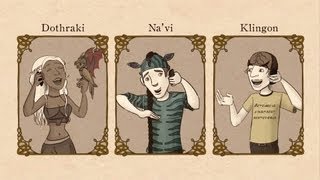(单词翻译:单击)
To many, one of the coolest things about 'Game of Thrones' is that the inhabitants of the Dothraki Sea have their own real language.
对很多人来说,《权力的游戏》里面最酷的事情之一就是,多斯拉克海的居民们有着他们自己的语言。
And Dothraki came hot on the heels of the real language that the Na'vi speak in 'Avatar,'
多斯拉克语可以和《阿凡达》里面的纳美语相媲美,
which, surely, the Na'vi needed when the Klingons in 'Star Trek' have had their own whole language since 1979.
当然,自1979年起,还是《星际迷航》中克林贡语风靡的时候,纳美人也需要属于他们自己的完整的语言。
And let's not forget the Elvish languages in J.R.R. Tolkien's 'Lord of the Rings' trilogy,
别忘了,还有托尔金笔下《指环王》三部曲中的精灵语,
especially since that was the official grandfather of the fantasy conlangs.
被视作是奇幻作品中人造语言的始祖。
'Conlang' is short for 'constructed language.'
“Colang”是英文中“constructed”(人造的)和“language”(语言)的简称。
They're more than codes like Pig Latin,
人造语言不像儿童讲的黑话,
and they're not just collections of fabricated slang like the Nadsat lingo that the teen hoodlums in 'A Clockwork Orange' speak,
不只是简单的囊括一些俚语,就好像《发条橙》里面叛逆的年轻人们讲的话一样,
where 'droog' from Russian happens to mean 'friend.'
比如,英语中“droog”(街头黑帮)这个词在俄语中刚好是“朋友”的意思。
What makes conlangs real languages isn't the number of words they have.
使人造语言真正成为完善语言体系的不是它涵盖了多少单词。
It helps, of course, to have a lot of words.
当然,单词量大也是一个优势。
Dothraki has thousands of words. Na'vi started with 1,500 words.
多斯拉克语有几千个单词。纳美语从1500个单词发展起来。
Fans on websites have steadily created more.
各个网站的书迷们也陆续创造了更多的单词。
But we can see the difference between vocabulary alone and what makes a real language
但是我们知道,词汇和真正语言其实有差异
from a look at how Tolkien put together grand old Elvish, a conlang with several thousands words.
托尔金如何创造古精灵语就是一个很好的例子,古精灵语只有几千字但结构完整。
After all, you could memorize 5,000 words of Russian and still be barely able to construct a sentence.
毕竟即使熟背5000个俄文单词,你也不一定能够灵活造句。
A four-year-old would talk rings around you.
四岁的孩子都比你讲话更熟练。
That's because you have to know how to put the words together.
这是因为你需要知道怎么把单词连接在一起。
That is, a real language has grammar. Elvish does.
也就是说,一门真正的语言需要语法。精灵语就是有语法的。
In English, to make a verb past, you add an '-ed.' Wash, washed.
在英语中,要把一个动词变为过去式,需要在动词后面加上“ed”。比如:“Wash”(洗)的过去式是“washed”。
In Elvish, 'wash' is 'allu' and 'washed' is 'allune.' Real languages also change over time.
在精灵语中,“wash”是“allu”,过去式是“allune”。自然语言是会随着时间改变的。
There's no such thing as a language that's the same today as it was a thousand years ago.
一种语言从来都不会在一千年以前和今天是一模一样的。
As people speak, they drift into new habits, shed old ones, make mistakes, and get creative.
语言会适应人们的新习惯,摆脱那些过时的用法,犯一些小错误,然后创造新用法。
Today, one says, 'Give us today our daily bread.'
今天我们用英语讲:“Give us today our daily bread.”

In Old English, they said, 'Urne gedaeghwamlican hlaf syle us todaeg.'
在古英语中,我们讲:“Urne gedaeghwamlican hlaf syle us todaeg.”
Things change in conlangs, too. Tolkien charted out ancient and newer versions of Elvish.
人造语言也是有变化的。托尔金记录了古精灵语和新精灵语。
When the first Elves awoke at Cuiviénen, in their new language, the word for 'people' was 'kwendi,'
当第一批精灵在奎维内恩觉醒的时候,在他们的语言中,“人民”的单词是“kwendi”,
but in the language of one of the groups that moved away, Teleri,
但在其中一个迁移走了的种族--Teleri的语言中,
over time, 'kwendi' became 'pendi,' with the 'k' turning into a 'p.'
随着时间的推移,“kwendi”演变成了“pendi”,“k”演变成了“p”。
And just like real languages, conlangs like Elvish split off into many.
就像自然语言一样,人造语言,比如精灵语,也会形成许多分支。
When the Romans transplanted Latin across Europe, French, Spanish, and Italian were born.
罗马人将拉丁文带入欧洲大陆,演化成法语、西班牙语、意大利语。
When groups move to different places, over time, their ways of speaking grow apart, just like everything else about them.
当种族像不同地方迁移的时候,随着时间的推移,他们说话的方式也逐渐区分开来,就像他们的其他生活习惯一样。
Thus, Latin's word for hand was 'manus,' but in French, it became 'main,' while in Spain it became 'mano.'
因此,拉丁语中“手”是“manus”,而法语中,这个词演变成了“main”,西班牙语中演变成了“mano”。
Tolkien made sure Elvish did the same kind of thing.
托尔金赋予了精灵语同样的特性。
While that original word 'kwendi' became 'pendi' among the Teleri,
原词“kwendi”在Teleri种族中演变成了“pendi”,
among the Avari, who spread throughout Middle Earth, it became 'kindi' when the 'w' dropped out.
在Avari这个遍及中土世界的种族中演变成了“kindi”,“w”不见了。
The Elvish varieties Tolkien fleshed out the most are Quenya and Sindarin,
托尔金突出描写最多的两种精灵语分支是昆雅语和辛达林语,
and their words are different in the same way French and Spanish are.
这两种语言的单词是有差别的,就像法语和西班牙语的差别一样。
Quenya has 'suc' for 'drink,' Sindarin has 'sog.' And as you know, real languages are messy.
昆雅语讲“喝”是“suc”,辛达林语讲则是“sog”。我们知道,自然语言是有点散乱的。
That's because they change, and change has a way of working against order, just like in a living room or on a bookshelf.
因为自然语言一直在演变,改变是会打破常规的,就好像一间客厅,或是一个书架的样子。
Real languages are never perfectly logical.
自然语言不会符合完美的逻辑。
That's why Tolkien made sure that Elvish had plenty of exceptions.
这也是为什么托尔金如此坚定精灵语有非常多的例外现象。
Lots of verbs are conjugated in ways you just have to know. Take even the word 'know.'
我们要记住很多动词不同的变形方式。
In the past, it's 'knew,' which isn't explained by any of the rules in English. Oh well.
拿“know”(了解)这个词来说,它的过去式是“knew”,这不符合任何英语中的常规原则。好吧。
In Elvish, 'know' is 'ista,' but 'knew' is 'sinte.' Oh well.
在精灵语中,“了解”是“ista”,但过去式则是“sinte”。好吧。
The truth is, though, that Elvish is more a sketch for a real language than a whole one.
事实是,精灵语比起一个完整的语言更像一门自然语言的雏形。
For Tolkien, Elvish was a hobby rather than an attempt to create something people could actually speak.
对托尔金来说,创造精灵语是一种乐趣,他并没有希望创造一门真正会被人们日常使用的语言。
Much of the Elvish the characters in the 'Lord of the Rings' movies speak
在《指环王》中,角色们讲的大部分精灵语
has been made up since Tolkien by dedicated fans of Elvish based on guesses as to what Tolkien would have constructed.
被精灵语迷们根据他们对托尔金可能想要构建的想法编译出来。
That's the best we can do for Elvish because there are no actual Elves around to speak it for us.
这也是我们能为精灵语做的最大程度的贡献了,因为我们身边并没有真正的精灵族人讲精灵语给我们听。
But the modern conlangs go further.
但是,现代的一些人造语言更加完善。
Dothraki, Na'vi, and Klingon are developed enough that you can actually speak them.
多斯拉克语,纳美语和克林贡语的体系足够完善,以至于我们可以真正讲这些语言。
Here's a translation of 'Hamlet' into Klingon, although performing it would mean getting used to pronouncing 'k' with your uvula,
我们来看翻译成克林贡语版本的《哈姆雷特》,即使不断练习这门语言就会习惯用你的小舌去发“k“这个音,
that weird, cartoony thing hanging in the back of your throat.
那种怪异的,卡通化的感觉还是会在你喉咙里游走。
Believe it or not, you actually do that in plenty of languages around the world, like Eskimo ones.
不管你相信与否,这世界上很多语言都是这样的,比如爱斯基摩语。
Pronouncing Elvish is much easier, though.
相比起来,精灵语的发音则简单多了。
So, let's take our leave for now from this introduction to conlangs in Elvish
让我们现在就起程出发,通过这篇人造语言的简介,让我们用精灵语,
and the other three conlangs discussed with a heartfelt quad-conlangual valedictory:
还有其他三种我们讨论过的人造语言,来由衷地告别吧:
'A Na Marie!' 'Hajas!' Na'vi's 'Kiyevame!' 'Qapla!' and 'Goodbye!'
“A na marie!” “Hajas!”纳美语的“Kiyevame!” “Qapla!”,最后还有Goodbye!


